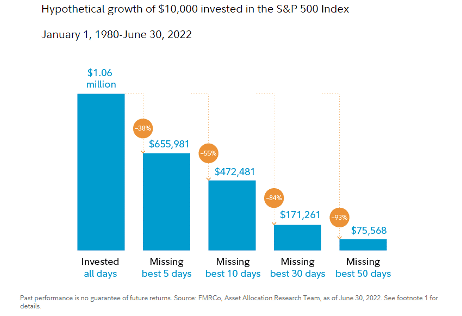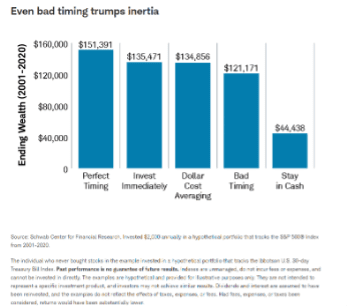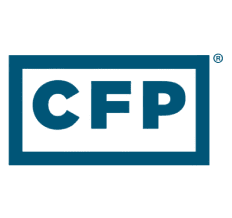Why You Shouldn’t Overlook Your Cash and Low-Risk Assets
Nov 7, 2022
Low-risk assets including cash are often overlooked versus short-term needs. Changing your mindset towards long-term goals can be a difficult one to navigate but can help you more in the long run. Some questions that might come to mind are: What is cash for? How much cash is too much? When is the last time I looked at what is in my savings or money market account versus my actual short-term needs?
One thing to look at is your opportunity costs. Opportunity cost is the lost of a potential gain from long-term investing versus keeping too much cash in a savings account. According to Business Insider, the average rate of return of the S&P 500 has been 10.7% since its inception in 1957 and the current savings rate is around 1%. [1] This means that in this scenario, if the S&P averaged around 10% long-term and you kept too much cash outside of emergency fund needs and other short-term needs, you may have missed out on 9% compounded growth on average with that money.
Another thing you should look at are inflation rates. Inflation is a huge impact on the true value of the US dollar. Last time we saw inflation this high was in the 1980s: CDs were around 18% while inflation was around 14%. [2][3] Today, national CD rates have fallen below 1% while inflation in the June CPI report rose to 9.1% over the past year. [2][3][4] This means that if inflation was 9% and your bank or CD rate this past year as 1%, you could have lost real return on your savings by 8%.
401(k) Mistakes
Many people don’t realize the mistakes you can make when moving money out of your 401(k). One of the most common ones is you can’t touch that money until your 59.5 or you will have penalty fees to pay. Some other common mistakes are people reduce contributions and trying to sell or try and time the market. Your 401(k) is a long-term retirement vehicle and you don’t want to cut corners because that can do more harm than good in the long run.
Time the Market Mistakes
No one can predict what the market will do on any given day. A good reference point for this is Fidelity’s ‘Missing the Best 5 Days Chart’ listed below. [5] By missing 5 good days in the market alone, the hypothetical shows a decrease in 38% total revenue that could have been used for retirement. Another example of this is Schwab’s ‘Five Investing Styles’ listed below as well. [6] This chart explains that even buying into the peak of the market ever year, you still were rewarded than if you kept money in cash.


Final Thoughts
You might be thinking, well how safe is TOO safe? Remember to assess your short-term needs, there is no need for you to go all in. You can investigate a few different options such as I-bonds for short-term. I-bonds can give you up to $10K/ person per year which will keep at least some of your savings from losing purchasing power by utilizing a low-risk investment tool. [7] Another option are DCA’s into ETFs for medium and long-term goals. If you have any questions or would like to speak to a financial advisor, please feel free to email me at [email protected].
Sources
- 1
https://www.businessinsider.com/personal-finance/average-stock-market-return
- 2
https://www.federalreservehistory.org/essays/great-inflation
- 3
https://www.nerdwallet.com/article/banking/historical-cd-rates
- 4
https://www.bls.gov/cpi/
- 5
https://www.fidelity.com/learning-center/personal-finance/protect-your-money-from-recession
- 6
https://www.schwab.com/learn/story/does-market-timing-work
- 7
https://www.treasurydirect.gov/indiv/research/indepth/ibonds/res_ibonds.htm
*Disclaimer:
This article is provided by Fortis Capital Advisors, LLC (“Fortis Capital Advisors” or the “Firm”) for informational purposes only. Investing involves the risk of loss and investors should be prepared to bear potential losses. Past performance may not be indicative of future results and may have been impacted by events and economic conditions that will not prevail in the future. No portion of this article is to be construed as a solicitation to buy or sell a security or the provision of personalized investment, tax, or legal advice. Certain information contained in this report is derived from sources that Fortis Capital Advisors believes to be reliable; however, the Firm does not guarantee the accuracy or timeliness of such information and assumes no liability for any resulting damages.
Any references made regarding the taxable nature of your investments should not be construed as tax advice. Fortis Capital Advisors, LLC is not a tax advisory firm; therefore, any tax decisions or assumptions should be made/verified with your tax professional.
Projected savings presented may vary depending on client longevity, and performance of assets over time.
This article is the sole opinion of this individual and is not indicative of the firm’s belief.







